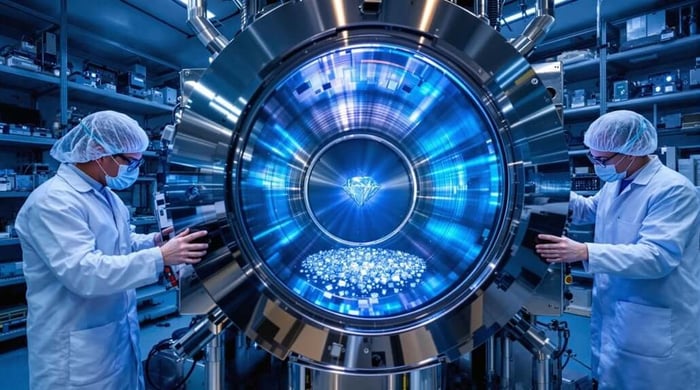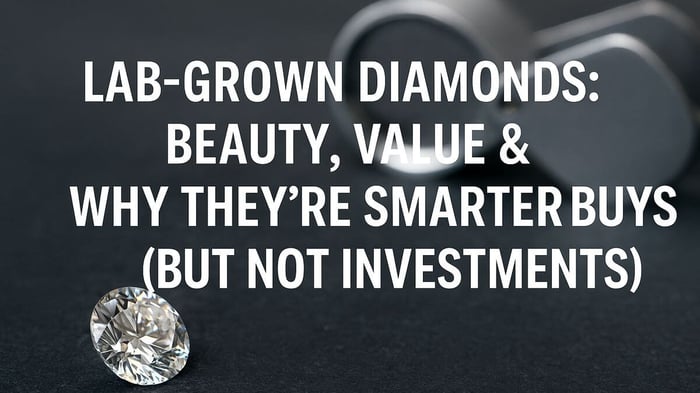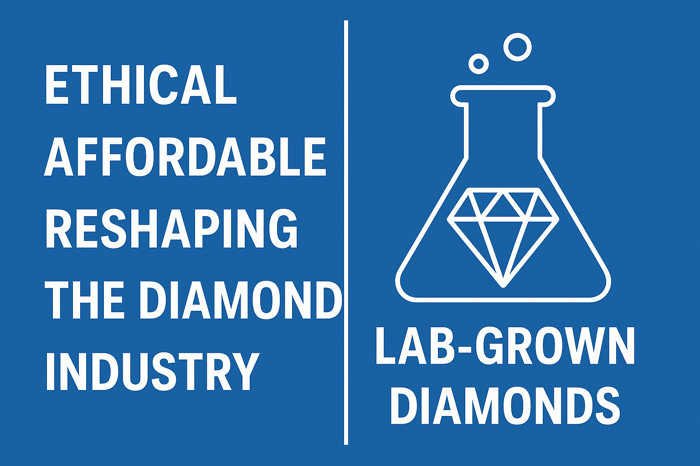In This Article
- Article Summary
- Understanding Lab-Grown Diamonds
- The High Pressure High Temperature (HPHT) Method
- The Chemical Vapour Deposition (CVD) Method
- Accelerated Diamond Formation Timeline
- Replicating Earth's Mantle Conditions
- The Atomic Structure of Lab Diamonds
- Comparing Lab Diamonds and Natural Diamonds
- The Environmental Impact of Lab Diamond Production
- A Modern Diamond Story — Sustainably Yours
Did you know that lab diamonds can be created in just a few weeks? Unlike natural diamonds, which take millions of years to form deep within the Earth, lab diamonds are born through advanced scientific techniques. These processes mimic the extreme heat and pressure found in the Earth's mantle.
Curious about how these stunning stones are made and what sets them apart from their natural counterparts? Let’s investigate the fascinating science behind the sparkle.
Article Summary
- Lab-grown diamonds are created in weeks using processes that mimic natural formation, unlike mined diamonds that take millions of years to develop.
- The High Pressure High Temperature (HPHT) method mimics the Earth’s conditions, requiring extreme heat and pressure to crystallise carbon quickly.
- The Chemical Vapour Deposition (CVD) method deposits carbon onto a diamond seed in a heated chamber, producing high-quality diamonds in just weeks.
- Lab diamonds are chemically identical to natural diamonds, ensuring they possess the same brilliance and durability without the lengthy formation time.
- Advanced technology and controlled environments lead to lower environmental impact and cost-effective production, promoting sustainability in the jewellery industry.
Ella Lab Diamond Solitaire Engagement Ring 4.00ct D/VVS 18k Yellow Gold
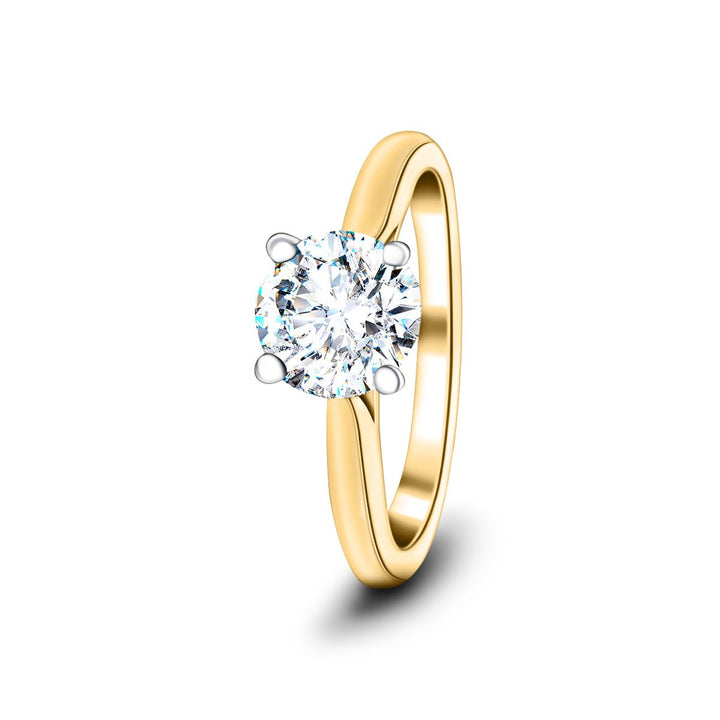
£2,690.00
£18,041.00
This stunning Ella Lab Diamond Solitaire Engagement Ring features a 4.00ct D/VVS-graded lab-created diamond set in 18k yellow gold. Handcrafted in the UK with an IGI-certified brilliant round diamond and a lifetime workmanship guarantee. This ring is an exquisite symbol… read more
Understanding Lab-Grown Diamonds
Advanced scientific processes create lab diamonds, often viewed as the modern alternative to natural diamonds.
These stunning stones have synthetic origins, formed in controlled environments rather than over millions of years. The identical optical properties make lab diamonds indistinguishable from natural ones without specialised equipment.
Using a method called Chemical Vapour Deposition (CVD), carbon-rich gases are heated and ionised, allowing carbon atoms to bond to diamond seeds. This process takes weeks or months to create beautiful crystals. HPHT and CVD are the primary methods of synthetic diamond production, showcasing the innovation behind these remarkable gems. Unlike natural diamonds, which form deep underground under high pressure and temperature, lab diamonds are ethically sourced, making them a socially responsible choice for jewellery.
They boast identical chemical structures to natural diamonds, giving you the same sparkle without the ethical dilemmas.
The High Pressure High Temperature (HPHT) Method
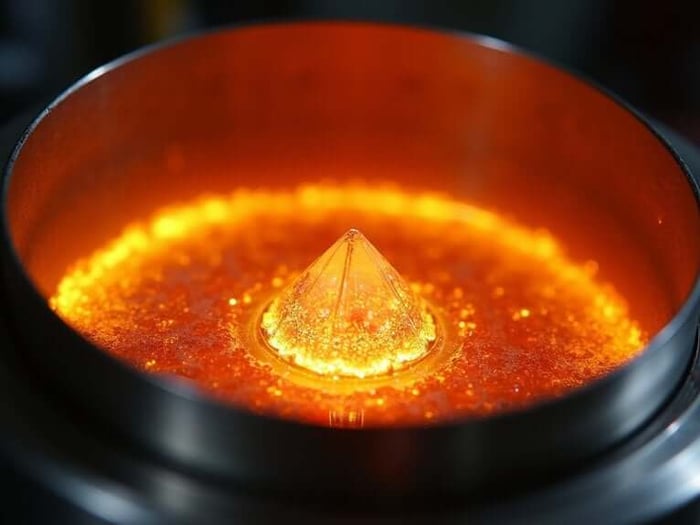
The High Pressure High Temperature (HPHT) method creates diamonds in weeks through extreme conditions. You'll find this process fascinating as it mimics natural diamond formation.
1. Diamond Seeding: A small diamond seed acts as the foundation for crystal growth.
2. Extreme Conditions: Superheated carbon at 1300–2200°C and pressure applications exceeding 1.5 million PSI set the stage.
3. Gradual Crystallisation: Carbon atoms precipitate onto the seed over days, forming a cubic structure. The resulting diamonds are chemically and optically identical to natural diamonds, showcasing the remarkable advancements in lab-grown technology. Additionally, HPHT diamonds often exhibit distinctive colour distributions and internal growth patterns, highlighting the uniqueness of the synthetic creation process. The cost-effective production results in diamonds up to 80% cheaper than mined stones.
As pressure levels reach 5–6 GPa, (Giga Pascals)and temperature variations are precisely controlled, a diamond emerges.
The final cooling solidifies the synthetic stone, ready for cutting and polishing. This method showcases how science can create beauty quickly and efficiently, allowing you to enjoy stunning diamonds without waiting millions of years.
Lab Diamond Cluster Pendant Necklace 1.00ct D/VVS in 9k Rose Gold

£730.00
£1,395.00
This exquisite Lab Diamond Cluster Pendant Necklace features a total diamond weight of 1.00ct, with each stone boasting a D/VVS quality for exceptional clarity and brilliance. The round-shaped, ethically sourced diamonds are masterfully set in a captivating cluster design, accentuating… read more
The Chemical Vapour Deposition (CVD) Method
Additionally, the CVD process can produce diamonds that are often more flawless than their naturally mined counterparts. With the industry projected to reach $37.32 billion by 2028, CVD diamonds represent a rapidly growing segment of the luxury jewellery market.
CVD Process Overview
The Chemical Vapour Deposition (CVD) method is a fascinating process that allows for the creation of diamonds in a laboratory setting. This technique involves several key steps that guarantee you get high-quality diamonds in just weeks.
1. Diamond seed selection: It begins with selecting a tiny diamond fragment as a template for growth.
2. Gas mixture composition: A mixture of methane and hydrogen gas is introduced into the reaction chamber. High purity methane and hydrogen are essential for optimal results during this stage. This method produces Type IIA diamonds that are rare in nature, lacking nitrogen and boron impurities.
3. High-temperature activation: The chamber heats up to about 600–900°C, ionising the gases and allowing carbon to deposit onto the seed.
Through this precise process, carbon builds up layer by layer, forming a beautiful diamond crystal.
You’re not just getting a diamond; you’re part of an inventive experience in jewellery creation!
Nancy Lab Diamond Halo Pear Engagement Ring 2.20ct G/VS in Platinum
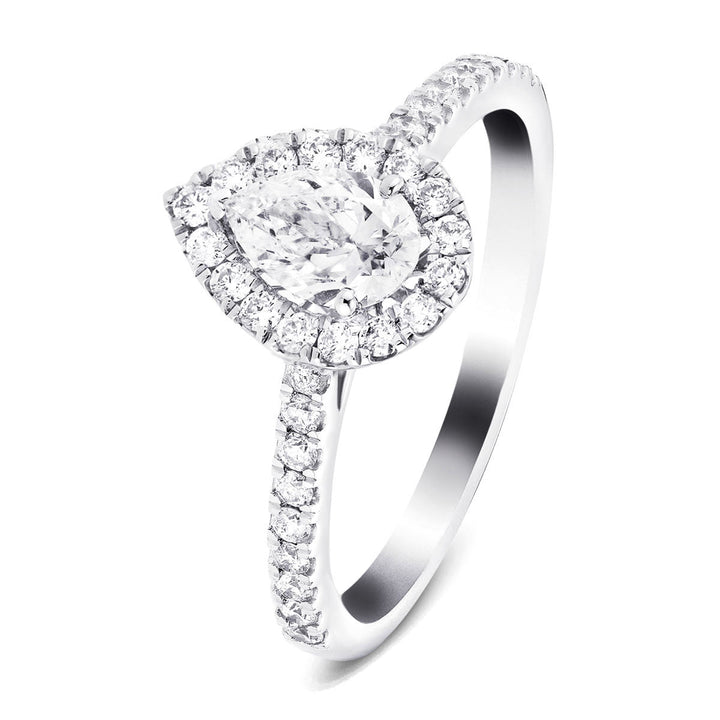
£1,906.00
£3,641.00
The radiance of love is illuminated in the beauty of this Nancy Lab Diamond Halo Pear Engagement Ring. This ring is handcrafted in platinum and features a 2.20ct total weight of G/VS-graded diamonds. The stunning pear-shaped diamond in the centre… read more
Growth Chamber Dynamics
Understanding how the growth chamber operates is fundamental for grasping the intricacies of the Chemical Vapour Deposition (CVD) method used to create lab-grown diamonds.
In this chamber, diamond seed crystals sit in a vacuum as methane and hydrogen gases fill the space. The chamber temperature is carefully controlled between 800–1200°C, optimising growth conditions. The diamond growth process includes nucleation and growth phases that are essential for producing high-quality crystals.
Pressure dynamics play a significant role; adjustments guarantee consistent crystal formation. Plasma generation occurs as high-frequency energy ionises gas molecules, creating a carbon-rich environment.
Maintaining gas purity is critical—impurities like nitrogen and oxygen are thoroughly monitored to keep them below parts-per-million levels.
These factors all contribute to growth optimisation, allowing for the creation of stunning lab-grown diamonds in just weeks.
Five Stone Lab Diamond Eternity Ring 3.50ct G/VS in 18k Yellow Gold

£2,298.00
£4,346.00
Experience the luxury of the Five Stone Lab Diamond Eternity Ring in 18k Yellow Gold. With a combined diamond weight of 3.50 carats of G/VS-certified diamonds, this ring is a true statement piece. The sparkling five diamonds shine brightly, illuminating… read more
Diamond Quality Factors
You’ll often find these diamonds certified by reputable labs like the GIA (Gemological Institute of America) or the International Mineralogical Institute (IGI). This certification guarantees you’re getting quality diamonds graded on the same standards as natural ones. Here are three key diamond quality factors to take into account:
1. Cut: The way a diamond is shaped impacts its brilliance and sparkle.
2. Colour: Just like mined diamonds, CVD diamonds can have slight colour tints, affecting their overall appearance. The CVD process allows for the production of colourless diamonds by using pure carbon and hydrogen gases.
3. Clarity: Inclusions or growth imperfections might still be present, even in lab-grown stones. Additionally, CVD diamonds can be produced at lower pressures than HPHT diamonds, which contributes to their overall quality.
With proper certification standards, you can trust the origin and quality of your diamond. Remember, the grading affects pricing, aligning with market demand for lab-grown diamonds.
Accelerated Diamond Formation Timeline
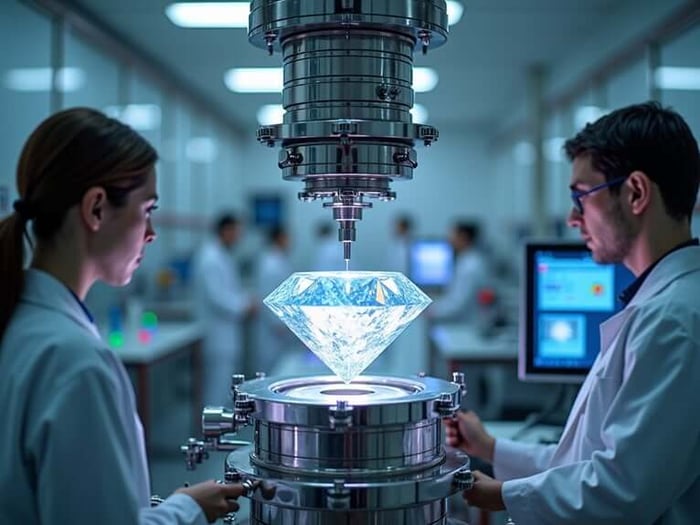
When you think about diamonds, you might imagine them taking millions of years to form deep within the Earth. Nonetheless, lab-grown diamonds can be created in just 2 to 6 months using advanced methods like HPHT and CVD. This swift growth process speeds up production and allows for large, high-quality stones that rival their natural counterparts.
The production process of lab-grown diamonds is highly controlled and utilises modern technology, primarily through two methods. In fact, CVD has become the primary method for producing lab-grown diamonds due to better control over properties and lower costs.
Rapid Growth Process
Understanding the rapid growth processes behind lab diamonds reveals just how quickly these gems can form.
Two primary methods drive this rapid crystallisation: HPHT and CVD. Each method accelerates diamond synthesis, yielding stunning results in weeks.
Here’s a quick breakdown:
1. HPHT Method: This method can create small crystals in just days, whereas larger stones may take up to three months. HPHT diamonds are generally of higher quality and aesthetics compared to CVD diamonds. Additionally, over 90% of HPHT diamonds submitted from 2021-2023 are classified as colourless, reflecting advancements in production techniques.
2. CVD Method: It allows small diamonds to form in as little as two weeks, utilising layers to build the jewel.
3. Batch Variability: The timeline can vary based on diamond size and quality.
With these groundbreaking techniques, lab diamonds make it possible to enjoy beautiful stones without waiting millions of years.
You’re part of a modern diamond revolution!
6ct Lab Diamond Tennis Bracelet D/VVS Quality Set in 9k Yellow Gold
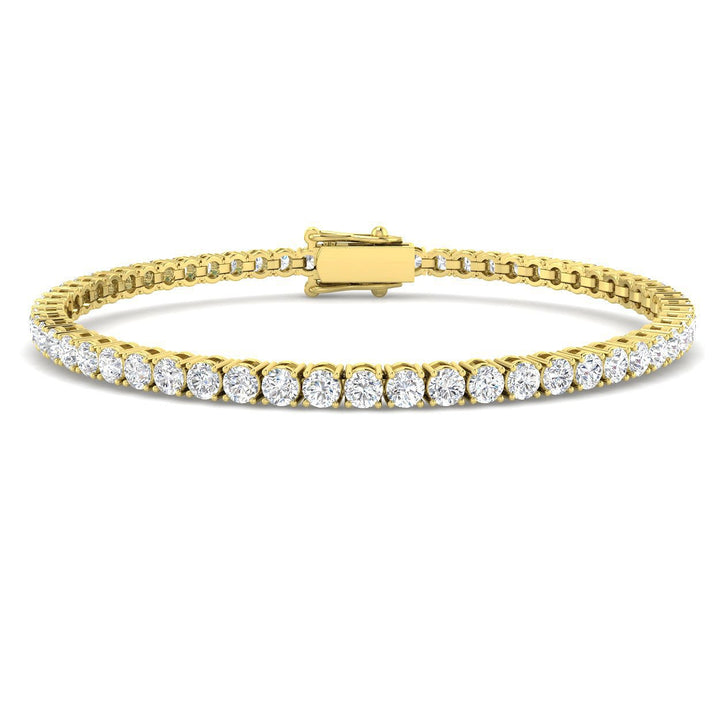
£1,896.00
£3,935.00
Exude timeless grace with this Lab Diamond Tennis Bracelet. The round lab-grown diamonds of D/VVS quality and weighing a total of 6 carats are beautifully set in 9k Yellow Gold, and the resulting sparkle is nothing short of mesmerising. The… read more
Comparison to Natural Diamonds
Understanding the differences between lab diamonds and their natural counterparts highlights the incredible pace at which each forms. Natural diamonds take 1 to 3.3 billion years to develop deep underground. Conversely, lab diamonds grow in just weeks through synthetic processes that mimic these natural conditions.
Here are some key points:
- Formation Depth: Natural diamonds form 150–200 km deep, whereas lab diamonds are created in controlled environments.
- Pressure and Temperature: Natural diamonds require extreme conditions of 45–60 kilobars and 900–1,300°C, which lab processes replicate. Natural diamonds form over billions of years, while labs can produce them in a matter of days. Additionally, the discovery of new diamond deposits in places like Brazil and South Africa has also influenced the natural diamond market, showing the ongoing evolution of diamond sources.
When comparing natural vs. synthetic diamonds, it’s important to note that both can hold significant diamond value, but the swift formation of lab diamonds makes them more accessible for many.
Replicating Earth's Mantle Conditions
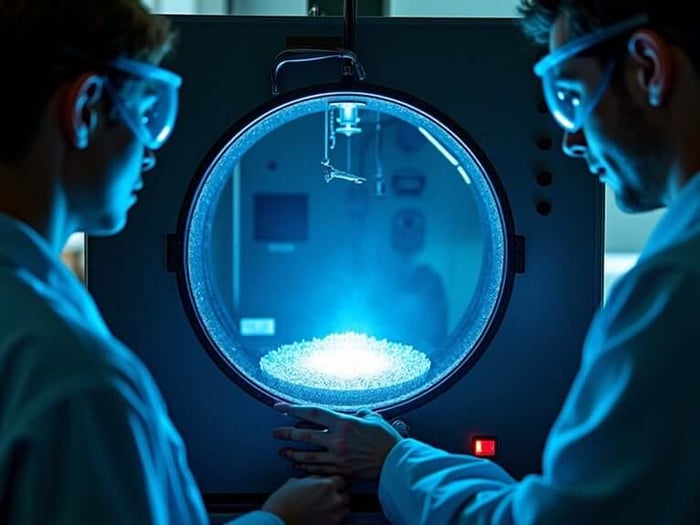
To replicate the extreme conditions of the Earth’s mantle in a laboratory, scientists employ a range of sophisticated techniques that mimic the immense pressure and temperature found deep beneath the surface. This is essential for diamond formation, as these mantle conditions drive the process. Here are three key methods they use:
1. Pressure-Temperature Conditions: They create depths exceeding 150 km and temperatures reaching up to 3,870°C.
2. Chemical Reactions: Water-mediated reactions and carbon sources from the core interact to stabilise diamonds, allowing for the potential liberation of core carbon during the process.
3. Electric Fields: Localised electric fields help induce diamond nucleation in high-pressure environments. Additionally, these processes mirror the conditions that allow diamonds to rise from the mantle during volcanic eruptions.
The Atomic Structure of Lab Diamonds
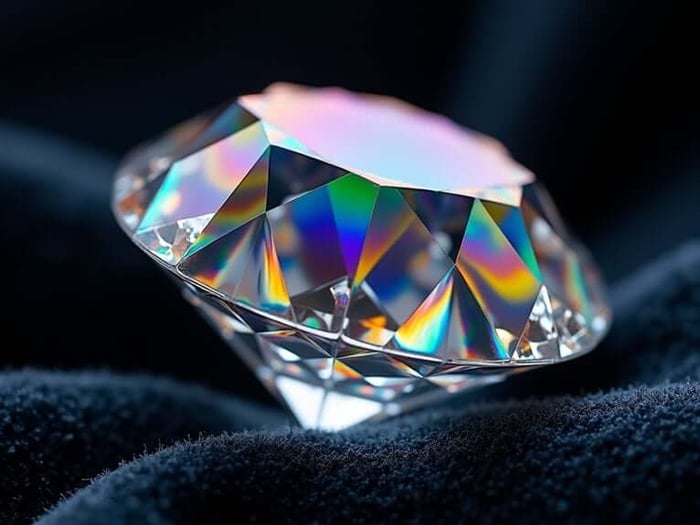
Understanding the atomic structure of lab-grown diamonds reveals why they sparkle just as brightly as their natural counterparts. Both types of diamonds are composed entirely of carbon atoms, arranged in a repeating tetrahedral structure. This ensures they share exceptional brilliance and durability, due to the strong covalent bonds between the carbon atoms.
Moreover, advanced gemmological laboratories can detect growth history differences between lab-grown and natural diamonds, highlighting the importance of understanding their origins. Furthermore, both types of diamonds have the same elemental makeup, which contributes to their similar optical properties.
Here’s a brief look at their atomic characteristics:
| Feature | Lab-Grown Diamonds | Natural Diamonds |
| Composition | 100% carbon atoms | 100% carbon atoms |
| Atomic Arrangement | Tetrahedral lattice | Tetrahedral lattice |
| Structural Integrity | High purity, no weak spots | Varies with impurities |
This precise atomic arrangement gives lab-grown diamonds their stunning transparency and fire, making them just as desirable as their natural siblings.
Lab Diamond Cuban Link Bracelet 5.50ct in 9k Rose Gold
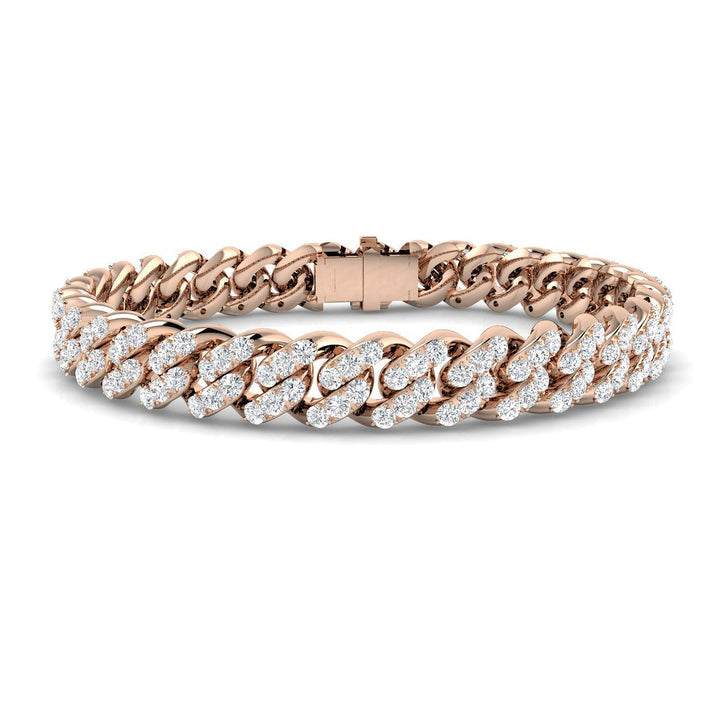
£2,700.00
£5,995.00
Immerse yourself in the epitome of luxury with the Lab Diamond Cuban Link Bracelet. This striking and stylish accessory features a dazzling 5.50ct of D/VVS quality real diamonds, set in a pave arrangement that captures the light from every angle,… read more
Comparing Lab Diamonds and Natural Diamonds
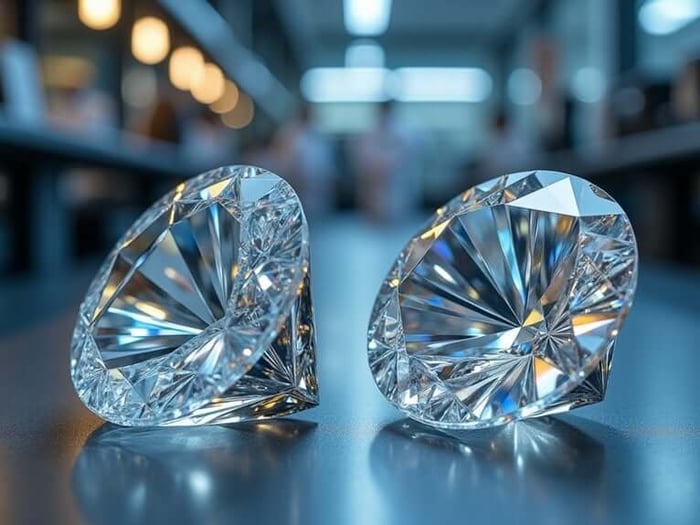
When you compare lab diamonds and natural diamonds, you'll find some intriguing differences that might just change how you view these sparkling stones. Here’s a quick look:
1. Ethical Sourcing: Lab diamonds are created in controlled environments, guaranteeing no unethical mining practices are involved. Perhaps the shimmering Northern Lights seen in the far north can be seen as a metaphor for the beauty and uniqueness that lab diamonds possess, as they are crafted without the environmental and ethical concerns associated with natural diamonds. Additionally, lab diamonds significantly reduce land use compared to their mined counterparts.
2. Price Comparison: Lab diamonds typically cost 60-85% less than natural diamonds of the same size and quality. The variance usually decreases when a diamond undergoes cutting, polishing, and mating with a precious metal setting. This affordability allows you to choose a larger stone without exceeding your budget.
3. Quality Assurance: Both types receive grading reports from reputable agencies, confirming they meet the same gemological standards. Ultimately, your choice reflects personal values and preferences—whether you prioritise ethics, price, or tradition in your sparkling stone.
Lab Diamond Three Stone Bangle 0.75ct in D/VVS 925 Silver

£407.00
£905.00
Unveil the essence of modern elegance with the Lab Diamond Three Stone Bangle, a masterpiece crafted in 925 Silver. This striking bangle features 0.75ct of real diamonds in a tension setting, showcasing a trio of gems that symbolize the past,… read more
The Environmental Impact of Lab Diamond Production
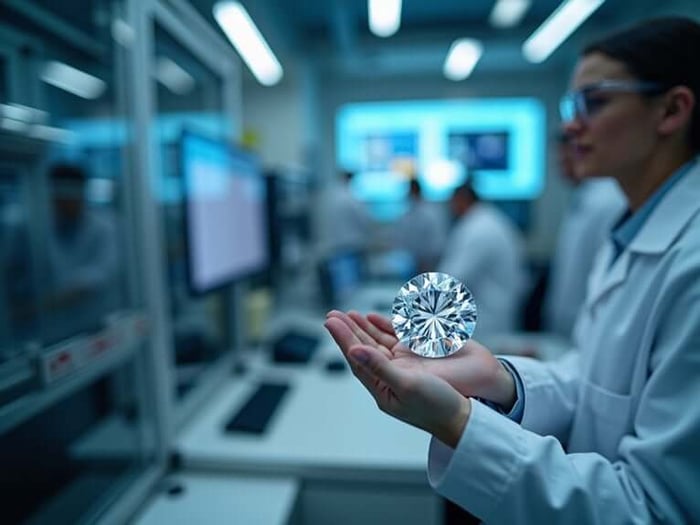
The environmental impact of lab diamond production is significantly lower than that of mined diamonds, making it an appealing choice for eco-conscious consumers.
Choosing lab diamonds offers important sustainability benefits.
- Reduced Emissions: Lab diamonds emit only 0.028 grams of CO₂ per carat, compared to 57,000 grams for mined diamonds.
- Resource Efficiency: Lab production uses 6.8 times less water and generates 4,383 times less waste than mining. In fact, the majority of lab-grown diamonds are produced in countries that prioritise energy-efficient practices, significantly reducing overall resource consumption.
- Biodiversity Preservation: Lab growth avoids the habitat destruction associated with mining operations.
Two Row Channel Set Lab Diamond Half Eternity Ring 1.00ct D/VVS in Platinum
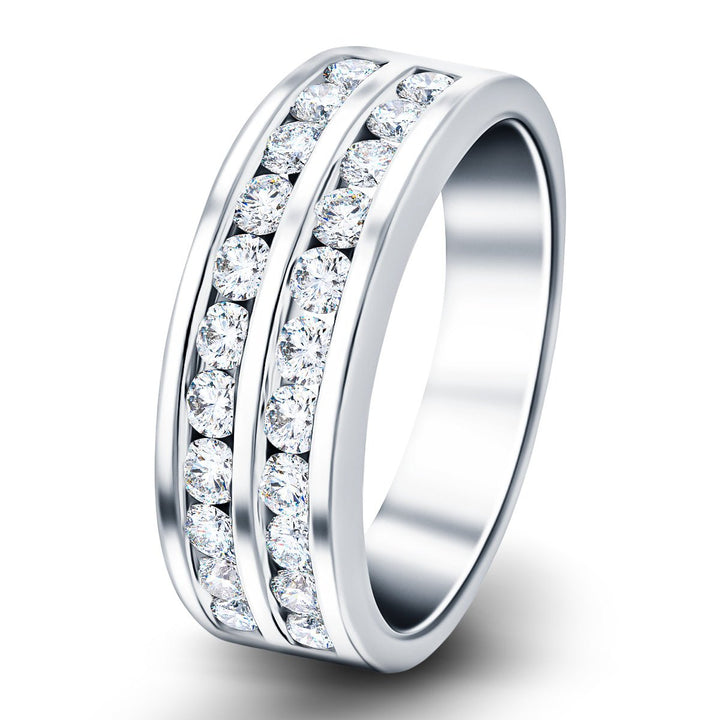
£1,250.00
£2,755.00
Celebrate enduring elegance with the Two Row Channel Set Lab Diamond Half Eternity Ring, featuring a total of 1.00ct D/VVS quality lab diamonds. These meticulously selected stones are set in a secure channel setting, displaying their round brilliance across the… read more
A Modern Diamond Story — Sustainably Yours
You don’t need to rely on chance to own a diamond that dazzles. At After Diamonds, we offer a modern way to experience the beauty and brilliance of diamonds—thoughtfully crafted in labs, not mined from the earth.
Our collection of lab-grown diamond jewellery delivers the same sparkle, purity, and elegance as natural diamonds — but with a focus on sustainability, value, and ethical sourcing. Designed by British artisans, every piece reflects exceptional craftsmanship and comes with our lifetime workmanship guarantee for total peace of mind.
With After Diamonds, you can enjoy extraordinary diamonds — responsibly created, expertly crafted, and always exceptional.
Discover Our High-Value Lab-Grown Diamond Jewellery
References
* https://en.wikipedia.org/wiki/Synthetic_diamond
* https://www.gemsociety.org/article/lab-grown-diamond-production-methods/
* https://www.gia.edu/hpht-and-cvd-diamond-growth-processes
* https://www.miadonna.com/blogs/news/comparing-cvd-and-hpht-lab-grown-diamonds-which-is-better
* https://www.growndiamondcorp.com/blog/hpht-lab-grown-diamonds-history-process-and-benefits/


